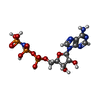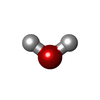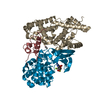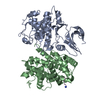+ Open data
Open data
- Basic information
Basic information
| Entry |  | |||||||||
|---|---|---|---|---|---|---|---|---|---|---|
| Title | Cryo-EM structure of CAK-CDK2-cyclin A2 bound to AMP-PNP | |||||||||
 Map data Map data | Post-processed, sharpened cryo-EM map. | |||||||||
 Sample Sample |
| |||||||||
 Keywords Keywords | Complex / cell cycle / kinase / TRANSFERASE | |||||||||
| Function / homology |  Function and homology information Function and homology information: / RNA polymerase II CTD heptapeptide repeat S5 kinase activity / cyclin A2-CDK1 complex / cell cycle G1/S phase transition / ventricular system development / cellular response to luteinizing hormone stimulus / snRNA transcription by RNA polymerase II / CAK-ERCC2 complex / transcription factor TFIIK complex / Transcription of E2F targets under negative control by p107 (RBL1) and p130 (RBL2) in complex with HDAC1 ...: / RNA polymerase II CTD heptapeptide repeat S5 kinase activity / cyclin A2-CDK1 complex / cell cycle G1/S phase transition / ventricular system development / cellular response to luteinizing hormone stimulus / snRNA transcription by RNA polymerase II / CAK-ERCC2 complex / transcription factor TFIIK complex / Transcription of E2F targets under negative control by p107 (RBL1) and p130 (RBL2) in complex with HDAC1 / cellular response to leptin stimulus / adult heart development / transcription factor TFIIH core complex / transcription factor TFIIH holo complex / male pronucleus / cyclin-dependent protein serine/threonine kinase activator activity / female pronucleus / cellular response to cocaine / [RNA-polymerase]-subunit kinase / response to glucagon / RNA Polymerase I Transcription Termination / positive regulation of DNA biosynthetic process / cyclin-dependent protein serine/threonine kinase regulator activity / cellular response to insulin-like growth factor stimulus / cyclin A1-CDK2 complex / cyclin E2-CDK2 complex / cyclin E1-CDK2 complex / cyclin A2-CDK2 complex / positive regulation of DNA-templated DNA replication initiation / G2 Phase / Y chromosome / cyclin-dependent protein kinase activity / Phosphorylation of proteins involved in G1/S transition by active Cyclin E:Cdk2 complexes / RNA Pol II CTD phosphorylation and interaction with CE during HIV infection / RNA Pol II CTD phosphorylation and interaction with CE / positive regulation of heterochromatin formation / p53-Dependent G1 DNA Damage Response / HIV Transcription Initiation / RNA Polymerase II HIV Promoter Escape / Transcription of the HIV genome / RNA Polymerase II Promoter Escape / RNA Polymerase II Transcription Pre-Initiation And Promoter Opening / RNA Polymerase II Transcription Initiation / RNA Polymerase II Transcription Initiation And Promoter Clearance / Formation of the Early Elongation Complex / Formation of the HIV-1 Early Elongation Complex / X chromosome / mRNA Capping / PTK6 Regulates Cell Cycle / regulation of anaphase-promoting complex-dependent catabolic process / Defective binding of RB1 mutants to E2F1,(E2F2, E2F3) / centriole replication / Regulation of APC/C activators between G1/S and early anaphase / regulation of DNA replication / telomere maintenance in response to DNA damage / microtubule organizing center / centrosome duplication / RNA Polymerase I Transcription Initiation / regulation of G1/S transition of mitotic cell cycle / G0 and Early G1 / cochlea development / RNA polymerase II transcribes snRNA genes / Telomere Extension By Telomerase / animal organ regeneration / Activation of the pre-replicative complex / cyclin-dependent kinase / ATP-dependent activity, acting on DNA / cyclin-dependent protein serine/threonine kinase activity / TP53 Regulates Transcription of Genes Involved in G1 Cell Cycle Arrest / Tat-mediated elongation of the HIV-1 transcript / Formation of HIV-1 elongation complex containing HIV-1 Tat / Activation of ATR in response to replication stress / Regulation of MITF-M-dependent genes involved in cell cycle and proliferation / Cajal body / Cyclin E associated events during G1/S transition / Formation of HIV elongation complex in the absence of HIV Tat / Cyclin A:Cdk2-associated events at S phase entry / Cyclin A/B1/B2 associated events during G2/M transition / cyclin-dependent protein kinase holoenzyme complex / RNA Polymerase II Transcription Elongation / Formation of RNA Pol II elongation complex / condensed chromosome / regulation of G2/M transition of mitotic cell cycle / cellular response to platelet-derived growth factor stimulus / mitotic G1 DNA damage checkpoint signaling / RNA Polymerase II Pre-transcription Events / positive regulation of smooth muscle cell proliferation / RNA polymerase II CTD heptapeptide repeat kinase activity / cellular response to nitric oxide / post-translational protein modification / regulation of mitotic cell cycle / cyclin binding / positive regulation of DNA replication / meiotic cell cycle / male germ cell nucleus / nucleotide-excision repair / TP53 Regulates Transcription of DNA Repair Genes / transcription initiation at RNA polymerase II promoter / Cdc20:Phospho-APC/C mediated degradation of Cyclin A / RNA Polymerase I Promoter Escape Similarity search - Function | |||||||||
| Biological species |  Homo sapiens (human) Homo sapiens (human) | |||||||||
| Method | single particle reconstruction / cryo EM / Resolution: 2.5 Å | |||||||||
 Authors Authors | Cushing VI / Greber BJ / McGeoch AJS / Feng J | |||||||||
| Funding support |  United Kingdom, 2 items United Kingdom, 2 items
| |||||||||
 Citation Citation |  Journal: Science / Year: 2025 Journal: Science / Year: 2025Title: Structural basis of T-loop-independent recognition and activation of CDKs by the CDK-activating kinase. Authors: Victoria I Cushing / Amy J S McGeoch / Sophie L Williams / Theodoros I Roumeliotis / Junjie Feng / Lucy M Dan / Jyoti S Choudhary / Norman E Davey / Basil J Greber /  Abstract: Cyclin-dependent kinases (CDKs) are prototypical regulators of the cell cycle. The CDK-activating kinase (CAK) acts as a master regulator of CDK activity by catalyzing the activating phosphorylation ...Cyclin-dependent kinases (CDKs) are prototypical regulators of the cell cycle. The CDK-activating kinase (CAK) acts as a master regulator of CDK activity by catalyzing the activating phosphorylation of CDKs on a conserved threonine residue within the regulatory T-loop. However, structural data illuminating the mechanism by which the CAK recognizes and activates CDKs have remained elusive. In this study, we determined high-resolution structures of the CAK in complex with CDK2 and CDK2-cyclin A2 by cryogenic electron microscopy. Our structures reveal a T-loop-independent kinase-kinase interface with contributions from both kinase lobes. Computational analysis and structures of the CAK in complex with CDK1-cyclin B1 and CDK11 indicate that these structures represent the general architecture of CAK-CDK complexes. These results advance our mechanistic understanding of cell cycle regulation and kinase signaling cascades. | |||||||||
| History |
|
- Structure visualization
Structure visualization
| Supplemental images |
|---|
- Downloads & links
Downloads & links
-EMDB archive
| Map data |  emd_53027.map.gz emd_53027.map.gz | 45.8 MB |  EMDB map data format EMDB map data format | |
|---|---|---|---|---|
| Header (meta data) |  emd-53027-v30.xml emd-53027-v30.xml emd-53027.xml emd-53027.xml | 30.9 KB 30.9 KB | Display Display |  EMDB header EMDB header |
| Images |  emd_53027.png emd_53027.png | 84.9 KB | ||
| Masks |  emd_53027_msk_1.map emd_53027_msk_1.map | 48.9 MB |  Mask map Mask map | |
| Filedesc metadata |  emd-53027.cif.gz emd-53027.cif.gz | 8.4 KB | ||
| Others |  emd_53027_half_map_1.map.gz emd_53027_half_map_1.map.gz emd_53027_half_map_2.map.gz emd_53027_half_map_2.map.gz | 37.8 MB 37.8 MB | ||
| Archive directory |  http://ftp.pdbj.org/pub/emdb/structures/EMD-53027 http://ftp.pdbj.org/pub/emdb/structures/EMD-53027 ftp://ftp.pdbj.org/pub/emdb/structures/EMD-53027 ftp://ftp.pdbj.org/pub/emdb/structures/EMD-53027 | HTTPS FTP |
-Validation report
| Summary document |  emd_53027_validation.pdf.gz emd_53027_validation.pdf.gz | 920 KB | Display |  EMDB validaton report EMDB validaton report |
|---|---|---|---|---|
| Full document |  emd_53027_full_validation.pdf.gz emd_53027_full_validation.pdf.gz | 919.6 KB | Display | |
| Data in XML |  emd_53027_validation.xml.gz emd_53027_validation.xml.gz | 11.4 KB | Display | |
| Data in CIF |  emd_53027_validation.cif.gz emd_53027_validation.cif.gz | 13.5 KB | Display | |
| Arichive directory |  https://ftp.pdbj.org/pub/emdb/validation_reports/EMD-53027 https://ftp.pdbj.org/pub/emdb/validation_reports/EMD-53027 ftp://ftp.pdbj.org/pub/emdb/validation_reports/EMD-53027 ftp://ftp.pdbj.org/pub/emdb/validation_reports/EMD-53027 | HTTPS FTP |
-Related structure data
| Related structure data |  9qcvMC  9i9iC  9i9jC  9i9kC  9qcxC  9skqC M: atomic model generated by this map C: citing same article ( |
|---|---|
| Similar structure data | Similarity search - Function & homology  F&H Search F&H Search |
- Links
Links
| EMDB pages |  EMDB (EBI/PDBe) / EMDB (EBI/PDBe) /  EMDataResource EMDataResource |
|---|---|
| Related items in Molecule of the Month |
- Map
Map
| File |  Download / File: emd_53027.map.gz / Format: CCP4 / Size: 48.9 MB / Type: IMAGE STORED AS FLOATING POINT NUMBER (4 BYTES) Download / File: emd_53027.map.gz / Format: CCP4 / Size: 48.9 MB / Type: IMAGE STORED AS FLOATING POINT NUMBER (4 BYTES) | ||||||||||||||||||||||||||||||||||||
|---|---|---|---|---|---|---|---|---|---|---|---|---|---|---|---|---|---|---|---|---|---|---|---|---|---|---|---|---|---|---|---|---|---|---|---|---|---|
| Annotation | Post-processed, sharpened cryo-EM map. | ||||||||||||||||||||||||||||||||||||
| Projections & slices | Image control
Images are generated by Spider. | ||||||||||||||||||||||||||||||||||||
| Voxel size | X=Y=Z: 1.09154 Å | ||||||||||||||||||||||||||||||||||||
| Density |
| ||||||||||||||||||||||||||||||||||||
| Symmetry | Space group: 1 | ||||||||||||||||||||||||||||||||||||
| Details | EMDB XML:
|
-Supplemental data
-Mask #1
| File |  emd_53027_msk_1.map emd_53027_msk_1.map | ||||||||||||
|---|---|---|---|---|---|---|---|---|---|---|---|---|---|
| Projections & Slices |
| ||||||||||||
| Density Histograms |
-Half map: Unfiltered half-map.
| File | emd_53027_half_map_1.map | ||||||||||||
|---|---|---|---|---|---|---|---|---|---|---|---|---|---|
| Annotation | Unfiltered half-map. | ||||||||||||
| Projections & Slices |
| ||||||||||||
| Density Histograms |
-Half map: Unfiltered half-map.
| File | emd_53027_half_map_2.map | ||||||||||||
|---|---|---|---|---|---|---|---|---|---|---|---|---|---|
| Annotation | Unfiltered half-map. | ||||||||||||
| Projections & Slices |
| ||||||||||||
| Density Histograms |
- Sample components
Sample components
+Entire : CAK-CDK2-cyclin A2 complex
+Supramolecule #1: CAK-CDK2-cyclin A2 complex
+Supramolecule #2: CDK-activating kinase (CAK)
+Supramolecule #3: CDK2-cyclin A2
+Macromolecule #1: Cyclin-dependent kinase 2
+Macromolecule #2: Cyclin-A2
+Macromolecule #3: CDK-activating kinase assembly factor MAT1
+Macromolecule #4: Cyclin-H
+Macromolecule #5: Cyclin-dependent kinase 7
+Macromolecule #6: PHOSPHOAMINOPHOSPHONIC ACID-ADENYLATE ESTER
+Macromolecule #7: MAGNESIUM ION
+Macromolecule #8: water
-Experimental details
-Structure determination
| Method | cryo EM |
|---|---|
 Processing Processing | single particle reconstruction |
| Aggregation state | particle |
- Sample preparation
Sample preparation
| Concentration | 0.4 mg/mL | |||||||||||||||
|---|---|---|---|---|---|---|---|---|---|---|---|---|---|---|---|---|
| Buffer | pH: 7.5 Component:
| |||||||||||||||
| Grid | Model: UltrAuFoil R1.2/1.3 / Material: GOLD / Mesh: 300 / Support film - Material: GOLD / Support film - topology: HOLEY / Pretreatment - Type: PLASMA CLEANING / Pretreatment - Time: 50 sec. | |||||||||||||||
| Vitrification | Cryogen name: ETHANE / Chamber humidity: 100 % / Chamber temperature: 278 K / Instrument: FEI VITROBOT MARK IV |
- Electron microscopy
Electron microscopy
| Microscope | TFS KRIOS |
|---|---|
| Specialist optics | Energy filter - Name: GIF Bioquantum |
| Image recording | Film or detector model: GATAN K3 BIOQUANTUM (6k x 4k) / Number grids imaged: 2 / Number real images: 33998 / Average electron dose: 50.0 e/Å2 |
| Electron beam | Acceleration voltage: 300 kV / Electron source:  FIELD EMISSION GUN FIELD EMISSION GUN |
| Electron optics | C2 aperture diameter: 50.0 µm / Illumination mode: FLOOD BEAM / Imaging mode: BRIGHT FIELD / Cs: 2.7 mm / Nominal defocus max: 2.2 µm / Nominal defocus min: 0.4 µm / Nominal magnification: 130000 |
| Sample stage | Specimen holder model: FEI TITAN KRIOS AUTOGRID HOLDER / Cooling holder cryogen: NITROGEN |
| Experimental equipment |  Model: Titan Krios / Image courtesy: FEI Company |
 Movie
Movie Controller
Controller










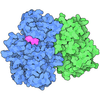
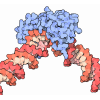
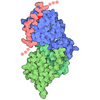
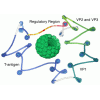



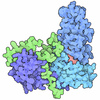

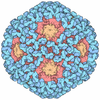

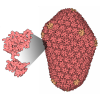

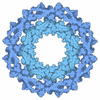

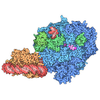
 Z (Sec.)
Z (Sec.) Y (Row.)
Y (Row.) X (Col.)
X (Col.)













































 Trichoplusia ni (cabbage looper)
Trichoplusia ni (cabbage looper)